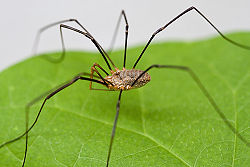READY TO GET STARTED?
REQUEST A FREE ESTIMATE
Fill out the form below or call (888) 466-7849 for a free, no-obligation estimate.
Daddy Long legs or Daddy Long legs Spider?
 Daddy Long legs, or harvestmen, are not actually spiders. Daddy long legs are not poisonous, have long legs and a large bulbous-looking body. They feed on insects, which makes them helpful around the garden. They are especially active at the time of harvest, toward the end of summer and beginning of fall. To keep daddy long legs away, vacuum carpet, upholstery, and curtains frequently to remove spider webs, adult spiders, and egg sacs. Be sure to dispose of the vacuum bag. Tightly seal the trash bag to make sure eggs can’t hatch and crawl out of the bag.
Daddy Long legs, or harvestmen, are not actually spiders. Daddy long legs are not poisonous, have long legs and a large bulbous-looking body. They feed on insects, which makes them helpful around the garden. They are especially active at the time of harvest, toward the end of summer and beginning of fall. To keep daddy long legs away, vacuum carpet, upholstery, and curtains frequently to remove spider webs, adult spiders, and egg sacs. Be sure to dispose of the vacuum bag. Tightly seal the trash bag to make sure eggs can’t hatch and crawl out of the bag.
Tip for preventing daddy long legs: Pour 1 cup white vinegar and 1/3 cup vanilla extract into a spray bottle and shake. Spray areas where the daddy long legs have been spotted indoors and out. The smell will repel the insects.
Daddy Long legs Spiders, or cellar spiders, although venomous, are not known to be harmful to humans. Their fangs are short and they do not have enough muscle to be able to penetrate human skin. Daddy long legs spiders are very fragile and delicate. They are usually brown or gray in color, cylindrical in shape and their legs are very long and thin. Daddy long legs spiders survive on others species of spiders, or on occasion they will invade other spiders’ webs and consume the host, their egg, and any prey caught in the web. They hang upside down on their webs, which they create in dark, damp places like home cellars, caves or abandoned animal burrows.
Tip for preventing daddy long leg spiders: To keep daddy long legs spiders away you will need caulk, a vacuum cleaner, a duster, boric acid/Borax, and spider traps. Caulk cracks in your walls, foundation, and loose window frames. With a vacuum cleaner attachment, suck up spiders and their webs at wall corners, undersides of furniture, floors beneath appliances, crevices along the baseboards and around windows and curtains. Insects attract daddy long legs spiders so dust frequently and repair leaking pipes and faucets both inside and out. Sprinkle boric acid under doorways, around window sills, along baseboards, and under appliances. Boric acid is a common ingredient in household cleaning products and is not harmful to humans and pets. Place spider traps in areas where spiders are usually seen.
Barry Teubert
Northwest Exterminating
Savannah Service Center
[email protected]
Before that “giant” bug showed up as an unexpected guest at your first barbeque of the spring, it started off life as a tiny egg. The process of growth and development that most insects experience is known as metamorphosis. During this process, insects will change shape, form and size until they reach the adult stage. There are several different types of metamorphosis including gradual metamorphosis, incomplete metamorphosis, and complete metamorphosis.
Some insects, however, grow and develop without metamorphosis. These insects, such as silverfish, grow and develop through a series of molts. When an insect’s exoskeleton no longer stretches to accommodate its size, it must shed this exoskeleton and grown a new one, while going through an intermediate phase known as instar. Until the insect reaches adulthood, or sexual maturity, it goes through several nymph stages that have the same appearance as the adult. At adulthood, molting ceases.
The insects that experience gradual metamorphosis include cockroaches, termites, bedbugs, and earwigs. They have three distinct stages in development – egg, multiple nymph stages, and adulthood. The nymphs begin to gradually resemble the adult as they grow, but do not have wings.
During incomplete metamorphosis, which occurs for dragonflies, damselflies, and mayflies, insects experience a transition from egg to naiad to adulthood. Naiads possess a different body structure and way of life from the adults. These nymphs live in water whereas the adults live on dry land and have wings.
The last form of complete metamorphosis occurs in beetles, moths, butterflies, flies, fleas, ants, bees and wasps. They go through four stages: egg, larva, pupa, and adult. Each stage has a different appearance. The larva hatches from the egg and then goes into a resting stage known as the pupa. During this stage, the insect changes from larvae to adult and fully develops its wings, legs, and antennae before emerging.
Sources:
Georgia Pest Control Employee Registration Manual